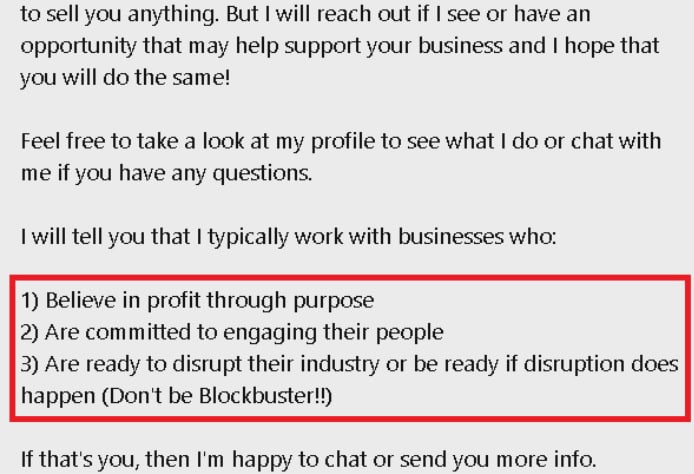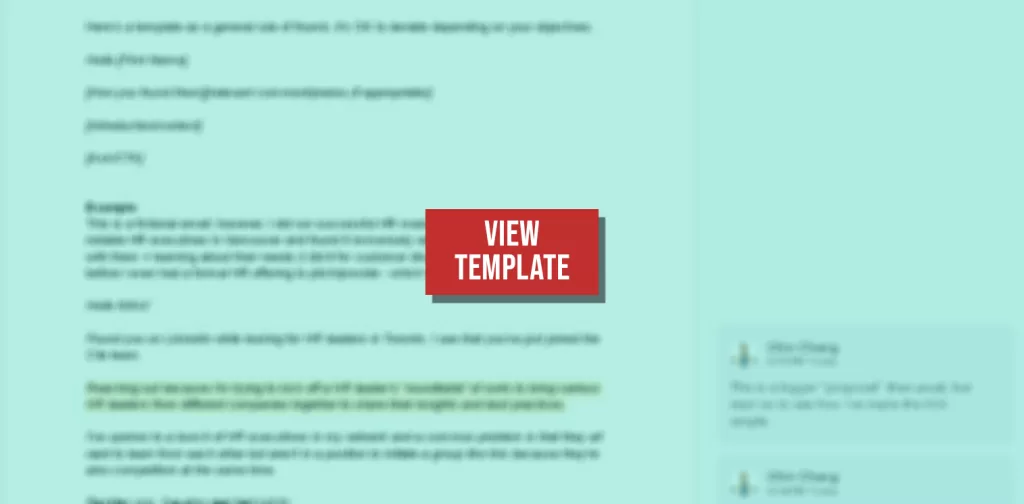Everything in this following section comes from Ramit Sethi’s “50 Proven Email Scripts”. If you find my paraphrase summary valuable, definitely check out the original, as it goes into a lot more detail and even includes analysis and critique of many sample emails. This applies not only to email or sales but also to any other form of persuasive communication. This framework can effectively be applied to approach mentors, find investors, or even secure meetings with notable journalists.
Start with the Subject Line
You can write the best email or message, but if it doesn’t get opened and read, it’s pointless.
A good subject line should be:
- Short
- Personalized
- Invokes curiosity or asks a question
Some examples include:
“Still raising capital?”
“Read your LinkedIn post on Generative AI”
“Found COMPANY on AngelList”
Message Body
The best practice for any message at any point in the conversation is to keep it simple. Complex discussions should be conducted over the phone or in a meeting. Deviation from this practice is acceptable as you become more familiar with someone, but it is still not recommended.
Scannable
If it’s optimized for mobile, it’ll probably be great for desktop too. Keep your paragraphs short, with no more than 2-3 lines, and space between paragraphs.
Formatting should be kept as plaintext instead of HTML
HTML emails may look prettier, but the formatting can trigger spam/promotion filters. Don’t rely on graphics and formatting to keep your email readable; instead, put in the work to communicate concisely and effectively.
Avoid Jargon
Even when communicating with an industry expert.
Write as if you’re writing to someone you know: When crafting cold outreach messages, we often default to a more distanced tone. As mentioned, when I discussed Yet Another Mail Merge as a Sales Tool, craft your email without merge tags and only replace them afterward.
Keep it simple
The more someone needs to think before responding, the less likely you are to receive a response. Sometimes it’s not even because they aren’t interested. They may leave your message in their inbox intending to reply when they feel more ready but forget to circle back. Use closed-ended instead of open-ended questions and avoid asking multiple questions. Make it as easy as possible for the recipient to reply.
Open-ended questions are valuable when you’re trying to ASSESS your prospect; however, in outreach, it’s still too early for them. Besides, those questions are best reserved for calls or meetings.
The Outreach Workflow
Message 1: Introduction/Ask
Message 2: Reminder
Message 3: Via a Different Channel
Message 4: Break Up
Applying the minimum of the 4-step follow-up process above almost guarantees improvement in response rates. I extensively use it myself and have seen it work with the companies I support when they adopt it as well.
Message 1: Introduction/Ask
Recall gradualization; rarely will it be appropriate to ask for a sale in the first interaction. The same applies if you’re using this outreach framework for finding an investor, mentor, or anything else. Your goal at this point is merely to gain permission to continue the interaction.
1. Start by identifying and explaining how you found or know of them, using language and values with which they associate. For instance:
- “I was researching restaurants with eco-conscious practices”
- Or, take a look at this LinkedIn cold outreach message I received. The rest of the messaging could use some improvement, but it did catch my attention because as someone who advocates for profit through purpose, I felt like he was calling out to me directly:

2. Follow closely with relevant and sincere praise about who they are and/or what they’ve done. Avoid superficial flattery.
3. Introduce yourself and why you’re reaching out.
4. Close with an Ask:
- If asking a question, make it easy for them to engage and reply.
- If trying to find a time for a call or meeting, use the Wide-Narrow Technique. For example:
“I’d love to jump on a quick 10-minute call (make the commitment clear) to… (be clear about the purpose of the call). Is Monday or Tuesday at 11am good (Narrow)? If not, I can also work around your schedule (Wide).”
Narrow: Makes it easy to say YES and pick a time or decline. They don’t have to figure out time zones or decide on options.
Wide: Acknowledges they are in the position of power and you’re willing to work around them, given that you’re often in the position of requesting in these messages. Power isn’t a reference to authority here. There’s usually someone who’s asking for something, and someone in the position to give it (time, attention, etc.). The one giving holds a higher power dynamic.
Message 2: Reminder
Sent 2-3 days after Message 1. Your goal is to be persistent without coming across as pushy. Don’t send them an unrelated email like “thought you should check this out…” or be apologetic about following up: “I’m sorry for being persistent or annoying…”. It should be short and simple, within two sentences.
1. Follow up. For example:
“My email may have gotten lost in your mailbox”
“Just wanted to follow up”
“Sending this to bump it up in your inbox”
2. Repeat/reiterate the ASK and remind them of why you’re reaching out so they won’t need to refer to the previous email.
Message 3: Via A Different Channel
Sent another 2-3 days after Message 2 and only if they have not responded to either. Reach out to them via a channel different from what you used for the original message. It could be email, LinkedIn, a call, X (Twitter), or even Facebook. Use your discretion, depending on the objective, it may be too personal to reach out to someone via Facebook.
1. Phrase with something along the lines of:
“Not sure if email is the best way to reach you, thought I’d try reaching out on…”
“Not sure if my emails are landing in your spam”
2. Repeat the ASK with new options for times (as the original timeslots have likely passed by now). But also, be prepared to engage in active discussion should they pick up the phone or are live on this social channel you’re reaching out on.
Message 4: Break Up
You may not need to get this far, but if you still don’t hear back, it doesn’t necessarily mean they aren’t interested. If they aren’t, they could still reply and decline. I’ve seen many instances where someone is interested but delays replying because they were waiting for a more opportune time or got too busy to get around to it.
Sent another 2-3 days after Message 3.
1. In Ramit Sethi’s framework, he introduces a concept called the Guilty Parachute:
Guilt: To make them feel a little bad for not replying sooner.
Parachute: An easy out so they won’t feel like the bad guy when they finally reply. For example:
“You might have been away over the long weekend/spring/summer/winter break”
“Totally understand if you’ve been busy”
I’m not exactly a fan of the guilt part as it is manipulative. Keep the “Parachute”, and instead of sending people on a guilt trip, emphasize why you sincerely want to hear back from them or believe your outreach will benefit them (not you, because we all already know there’s something you stand to gain from this interaction). What could this look like?
“I see from your website that you’re not currently selling your products online, and I truly believe our solution will help you unlock a lot of revenue by enabling you to do so.”
“I genuinely respect the advocacy work you do, and it would really mean a lot to me if you could give me some advice on…”
2. Break up, make it clear that it’s your last attempt. Something along the lines of:
“Thought I’d give this one last try. I won’t bother anymore if you don’t reply”
3. Repeat the ASK
Additional Resource: 8 cold email copywriting tips to email leads the right way (plus 3 templates) by PhantomBuster.
TEMPLATE
Ready to start crafting your outreach emails? View and customize this template.

